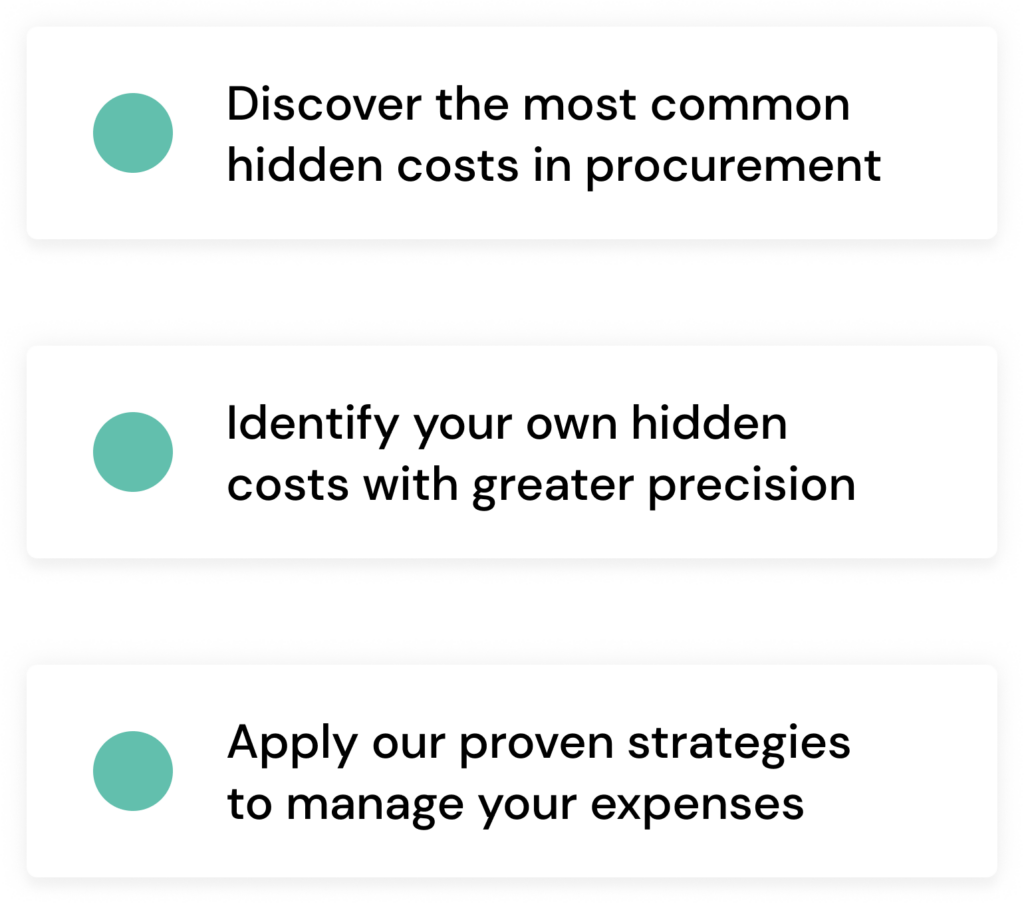Have you ever been caught off-guard by unexpected expenses in your procurement department?
Imagine this situation: You’ve painstakingly built a comprehensive spending policy for your organization, detailing preferred vendors and budget limits. Yet, at the end of the month, you’re faced with receipts from non-approved vendors, and expenses that don’t align with your established procurement guidelines.
If so, the likely culprit could be maverick spend.
Maverick spend is the act of buying goods or services that don’t align with a company’s predefined spending rules. More than just an unplanned purchase of office items, maverick spend usually hints at scenarios where workers don’t prioritize the company’s financial best practices. This can involve bypassing established procurement channels for new tools or services, or incurring costs without adequate reasons. Such deviations in purchasing habits can lead you to operational inefficiencies, increased expenses, and even potential hazards when dealing with unauthorized vendors.
In this article, we have compiled a list of 7 proven techniques to control procurement expenses, ensuring that maverick buying doesn’t derail your budget or compromise the integrity of your procurement processes.
Whether you’re struggling with occasional maverick spending or trying to understand what are its causes, here are the topics we will cover:
- Why Is It Important To Control Your Spend?
- What Are The Types And Causes Of Maverick Spend
- 7 Proven Way To Control Maverick Spend


Why Is It Important To Control Your Spend?
Have you considered the hidden costs and risks tied to unplanned purchases in your organization?
Firstly, without a tight rein on maverick spend, you might be missing out on substantial savings as purchases made outside the confines of well-negotiated contracts often lead to overpaying for goods or services. Moreover, the quality control of these purchases can often be subpar. Think of it as opting for an unknown brand over a trusted one; you’re more likely to receive goods that are of inferior quality with a maverick purchase.
Additionally, such spending behaviours can strain relationships with established vendors. Breaching agreed-upon contracts or terms can lead to a loss of trust. Plus, there’s the added peril of stepping into regulatory grey areas. Working with unknown suppliers, especially without thorough vetting, poses risks of regulatory non-compliance, which can have legal and financial implications for your company.
Then there’s the added administrative burden. Consider the accounting teams sifting through myriad transactions, trying to make sense of maverick spending. Instead of a streamlined process with familiar vendors, they’re left reconciling discrepancies due to rogue purchases. This not only wastes valuable time but also hinders the efficiency of your procurement team.
Lastly, maverick buying can disrupt your budgeting. After all, if expenditures are erratic and untracked, how can you accurately gauge if you’re overspending or staying within budgetary confines? Such unpredictability complicates budget planning and makes financial foresight challenging.
All in all, while the occasional unplanned purchase might seem harmless, the cumulative effect of maverick spend can negatively impact your bottom line, affecting everything from vendor relationships to profits.
What Are The Types And Causes Of Maverick Spend
Are you familiar with the various ways uncontrolled spending can present itself and what are the subtle ways it can infiltrate your procurement process?
Here are the three main types of maverick spend:
- Uncontrolled & Unknown: This refers to transactions where both the expense and the vendor are not recognized within your organization’s established procurement system. Picture receiving an invoice from an unfamiliar vendor, with no associated contract. It’s like a stranger knocking on your door, expecting payment.
- Partly Controlled & Partly Known: Here, while the vendor might be recognized, the specific transaction details are not entirely clear or within expected norms. Imagine getting an incomplete invoice from a vendor you’ve previously dealt with. You recognize the vendor, but the details of the transaction remain elusive, perhaps not matching any pre-agreed terms or expected items.
- Known & Partly Controlled: This situation describes transactions where the vendor and the nature of the purchase are recognized, but certain specifics of the transaction do not align with established processes or expectations. This scenario involves approved vendors and existing contracts. However, some transactional details, like quantities or pricing, might be amiss or not in line with the agreed terms.
Now that we’ve delved into the types of maverick spend you can encounter, we can focus on the 6 main root causes:
- Decentralization: A major culprit of maverick buying. Decentralization can stem from teams not collaborating or from scattered operations where each unit handles its purchasing. For instance, a corporate team may strike a deal, but individual business units might deviate from it.
- Purchasing Controls Implementation: Maverick buying can proliferate if your business lacks stringent purchasing controls. For instance, one of your employees might bypass established procedures and purchase a replacement part from an unvetted local supplier instead of using an approved vendor, leading to potential quality and compatibility issues.
- Absence of a Centralized System: Larger companies, especially those grown through acquisitions, might struggle with disparate purchasing systems, leading to challenges in enforcing a unified purchasing policy.
- No Standardized Purchase Process: Without a centralized purchasing procedure, different teams might adopt varied approaches, leading to inconsistencies.
- Indirect Spend Vulnerabilities: Especially pertinent to manufacturing sectors, where the bulk of the spend is direct and well-regulated, but auxiliary expenses like MRO supplies can introduce maverick purchase opportunities.
- Business Nature: Some businesses inherently have unpredictable spending patterns. For example, in emergency maintenance services, technicians might occasionally need to source urgent replacement parts from the nearest supplier, rather than wait for delivery from an approved vendor, to swiftly address a critical breakdown.
As a last note remember, recognizing the types and underlying causes of maverick buying is the first step in crafting effective strategies to curb such spending.
7 Proven Way To Control Maverick Spend
So far, we’ve covered the main types of maverick spend you’re likely to encounter and their root causes. However, how can you successfully implement the right processes to curb these expenses before they even manifest?
Here are 7 best practice you can follow:
- Spotting Rogue Purchases Through Spend Analysis: Begin your journey by diving deep into your company’s spend data. Be it credit card statements, invoices, financial documents, or modules from your Enterprise Resource Planning (ERP), collating this data can shed light on where the maverick spending is occurring.
- Clarifying Roles and Responsibilities: While your finance team might handle big-budget decisions, who’s looking after the everyday purchases? Control maverick spend by designating specific roles. Assign particular teams or individuals as the primary purchasers, setting clear budget limits, and ensuring every transaction undergoes the correct approval process.
- Maintaining a List of Approved Vendors: Streamline your purchasing by keeping a comprehensive list of your go-to suppliers. Leveraging vendor management software can assist in documenting preferred suppliers, ensuring this database is easily accessible to all stakeholders.
- Mandating Purchase Orders for Every Transaction: While it may seem daunting, having a purchase order for every buy can be transformative. Without it, spend commitments might fly under the radar. Plus, by laying down clear terms of business and payment, you set the foundation for enforcing them.
- Crafting a Transparent Purchase Policy: A clear, well-communicated purchase policy can act as your company’s compass, guiding every financial decision and ensuring alignment with your financial goals. After all, a precise purchase policy leaves no room for guesswork. Detail who can buy, what they can buy, and how much they can spend. Also, make it accessible, so there’s no excuse for bypassing it.
- Accelerating the Approval Mechanism: Delays in approvals can be a gateway to maverick spending, especially when there’s urgency. Assess your current processes, identify bottlenecks, and streamline them to ensure a smooth, quick approval process.
- Educating and Training: Knowledge is power. Regularly updating and training your staff about the nuances of maverick buying and its consequences can foster a more financially responsible environment. Ensure that your team is well-versed in identifying and controlling maverick spend.
All in all, controlling maverick spend is about implementing strong targeted processes along with a culture of financial responsibility, ensuring each purchase aligns with your company’s objectives.

Recognizing the types and underlying causes of maverick buying is the first step in crafting effective strategies to curb such spending.
Conclusion
At the heart of every flourishing business is not just the revenue it generates, but also the expenses it controls. In this article, we walked you through the intricacies of maverick spend – from its types and causes to best practices to control it.
As you move forward, keep these insights in your toolkit, ensuring that every purchase aligns with your company’s goals and vision. Ultimately, it’s the well-informed choices that pave the way for sustained growth.

















